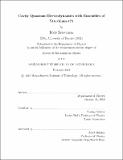Cavity quantum electrodynamics with ensembles of ytterbium-171
Author(s)
Braverman, Boris
DownloadFull printable version (16.44Mb)
Other Contributors
Massachusetts Institute of Technology. Department of Physics.
Advisor
Vladan Vuletić.
Terms of use
Metadata
Show full item recordAbstract
In this thesis, I present the realization of a system applying the tools of cavity quantum electrodynamics to an atomic optical lattice clock. We design and implement a unique experimental cavity structure, with a small radius of curvature mirror on one side and a large mirror on the other side. With this structure, we are able to probe ytterbium-171 atoms in both the weak and strong coupling regimes of cavity quantum electrodynamics. This asymmetric micromirror structure simultaneously offers strong light-atom coupling, mechanical robustness, and excellent access to a large cavity volume. We develop a simple but accurate model for strong light-atom interactions in our system, which allows us to predict the performance of both cavity-assisted quantum non demolition measurements of the atomic state, and the back-action of the probing light onto the atomic state. We find theoretically, and confirm experimentally, that probing the atom-cavity system with two frequencies at the vacuum Rabi peaks of a system with strong collective light-atom coupling generates the largest possible entanglement between the probing light and the atomic state. With this scheme, we demonstrate atomic number measurements within a factor of 2 of the quantum Fisher information limit. By using the quantum back-action of the probing light on the atomic ensemble, we perform squeezing by cavity feedback. We produce states with -11±1 dB of variance squeezing and 14±1 dB of anti squeezing. Using theoretical simulations, we show that states with near-unitary squeezing offer significant advantages for improving atomic clocks compared to previous work. The ability to load large atomic ensembles in the strong coupling regime in our system offers several routes to the generation of highly entangled non-Gaussian quantum states. Such states can be produced by heralded measurements, or by global atom-atom interactions based on unitary spin squeezing. Altogether, we realize a system of unprecedented versatility and great potential for performing a large variety of hybrid atomic clock and cavity QED experiments.
Description
Thesis: Ph. D., Massachusetts Institute of Technology, Department of Physics, 2018. This electronic version was submitted by the student author. The certified thesis is available in the Institute Archives and Special Collections. Cataloged from student-submitted PDF version of thesis. Includes bibliographical references (pages 313-328).
Date issued
2018Department
Massachusetts Institute of Technology. Department of PhysicsPublisher
Massachusetts Institute of Technology
Keywords
Physics.